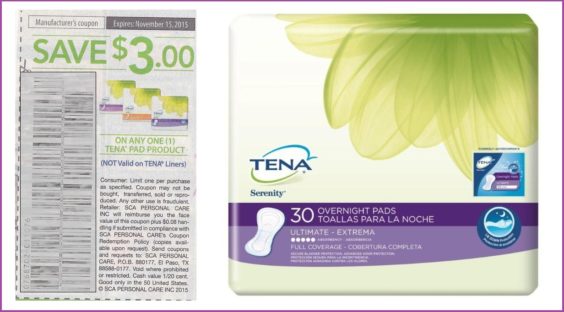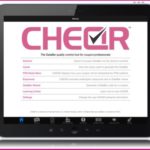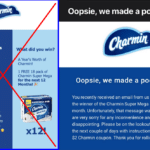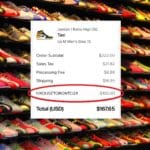
Looking forward to using a high-value coupon that appeared in last Sunday’s paper? Be warned – you may be short-changed, or your cashier may refuse to accept the coupon altogether, and hand it back to you.
The October 25th edition of the SmartSource coupon insert featured an offer for $3 off a product from incontinence care brand TENA. But many couponers have reported running into trouble trying to use it.
Turns out the coupon’s bar code is programmed to deduct only $1 instead of $3. And oh, it’s also encoded with an expiration date of August 26th. So mismatched coupon value aside, the bigger problem is that the coupon had already expired before it was even published.
So if your store has a coupon policy of “if it doesn’t scan, we can’t accept it” – you may be out of luck.
TENA ran a coupon in the July 26th edition of the SmartSource insert, that offered $1 off, and expired on August 26th. So it would appear that the company inadvertently used the old bar code on a new coupon offer.
An honest mistake. But try explaining that to a cashier who’s giving you the side-eye, suspecting you of doctoring an old expired $1 coupon to try to scam the store out of $3.
Some retailers’ scanners may not even be able to “read” the coupon’s expiration date, in which case the coupon will be accepted – but will deduct only a dollar. So if you’re not paying close attention, you won’t get the coupon’s full value. Even if a cashier manually pushes through the coupon to give you the full $3 off, when the store submits the coupon for reimbursement from the manufacturer, won’t it still scan at the coupon clearinghouse for just $1 off? So either your store loses $2 for every coupon it accepts, you save $2 less than you should, or you’re denied the ability to use the coupon at all.
TENA manufacturer SCA admits it goofed. “We apologize for any inconvenience this misprint may have caused our valued TENA shoppers and retailer partners,” SCA Consumer Marketing Director Carrie Harcus told Coupons in the News. “Where feasible, we ask that retailers’ in-store staff override the $1.00 coupon to redeem a $3.00 coupon… The coupon clearinghouses are aware of this situation and will honor all coupons presented to them by all retailers within the published redemption period.”
And if your store didn’t get that message? “If rejected at the register or customer service desk, we encourage (consumers) to give us a call,” Harcus said. “TENA is ready and staffed to accommodate all calls made to 1-866-ASK-TENA as a result of this coupon misprint.”
Score one for SCA, for its swift response in owning up to the issue and trying to make it right. But ironically enough, were it not for an invention aimed at improving coupons’ accuracy, this inaccurate coupon might never have been published at all.
Old-style coupon bar codes contained little more than the offer value, and a code linking the coupon to the manufacturer of the purchased product. But those bar codes were officially phased out earlier this year, in favor of the newer GS1 DataBars, which contain much more information. The idea was to reduce coupon fraud, and free cashiers from having to scrutinize purchase requirements, expiration dates and other stipulations printed on the coupon – they’re all in the bar code, so let the scanner do the work. In the interest of expediency, and due to a belief in the virtual infallibility of the information-packed DataBars, many retailers have adopted a policy that a coupon must scan properly in order to be accepted.
But what if a coupon isn’t printed properly? A precisely-coded DataBar may be infallible, but the coupon providers who create the DataBars aren’t.
Told you so, say the makers of a coupon app ostensibly designed to catch this kind of thing.
“One of the worst coupon errors we have ever seen,” QSeer co-founder Katherine Cary wrote on her Dusty Wallet blog. “If anyone ever asks why you need QSeer, just show them this TENA coupon.”
QSeer has courted plenty of controversy, for allowing users to scan a coupon’s bar code and see exactly how it’s encoded. Critics have said that only enables consumers to find weaknesses and omissions in bar codes, and take advantage of them by using high-value coupons on lower-priced items for which they’re not intended.
Cary insists the real purpose of QSeer is to alert consumers of incorrectly-coded coupons like the TENA offer, before they get to the checkout. “I keep picturing the humiliation of a woman buying TENA for her incontinence problem,” she told Coupons in the News. “That is embarrassing enough, but then when the coupon doesn’t scan correctly, I am imagining the cashier digging through the customer’s purchases, holding up the TENA package, scrutinizing it versus the coupon, and then calling over the manager. It sounds like a bit from a comedy act.”
If expiration dates weren’t hard-coded in coupons’ bar codes, and scanners weren’t thought to be the final arbiter of whether a coupon is valid, the TENA coupon wouldn’t automatically be rejected at the checkout (though it would still deduct only one dollar instead of three). So Cary says it’s imperative that coupon issuers get the bar codes right. “We find it amazing that the overall error rate on coupons continues to run close to 75%, and that the majority of errors are harmful to consumers,” she said.
The makers of TENA likely never intended to get in the middle of the debate between QSeer, which argues that consumers deserve more information about how their coupons are coded, and the coupon industry, which argues that consumers have no business knowing how coupons are coded, and no good can come of it. But while the industry has stopped short of publicly condemning QSeer, QSeer’s founders appear to take a certain delight in tweaking their critics, by cheerfully offering their assistance. “By the way,” Cary said, “we know how to fix these problems and are happy to help any manufacturers who want to improve the quality of their coupons.”
After the headaches that this one coupon is causing TENA’s manufacturer, retailers and consumers, it’s a good bet that the company will get its next coupon offer straightened out. “TENA stands ready to re-earn the trust and confidence of our consumers and retailers,” Harcus said.
And you can bet that consumers, retailers – and the makers of a certain coupon app – will be watching.











Pingback: Bad Barcode on Tena Coupon Makes it Unusable for Couponers! | Grocery Shop For FREE at The Mart!!